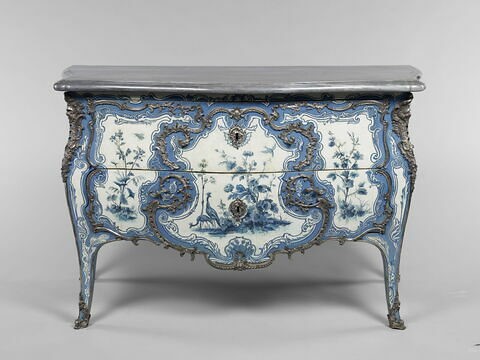France
by Kenta Takeshige
Oriental lacquerware was already introduced from Portugal and Spain in the late 16th century, and in 1604 the French East India Company (La companie des Indes orientales) was established and began trading themselves. Imported East Asian lacquerware adorned the French royal family, and the fashion spread to the aristocracy who followed suit. Due to the growing fascination and demand for these imported products, with their perfect glossy black surfaces and exotic decorations, French painters, japanning artisans, and gilders developed a tendency to imitate Asian lacquer crafts. From the second half of the 17th century, and particularly at the end of the 17th century, a wide range of lacquer colours (red, green, white, blue) became into fashion.
Jacques Dagly, a native of Spa, Belgium, who with his brother Gérard had run a widely renowned workshop in Berlin for more than 20 years. In 1713 Jacques co-founded a new workshop in Paris.1 He and his French associates worked for workshops in the Manufacture Royale des Gobelins were assigned to them by royal authorization.2 His japanning techniques became all the rage, and it was even said that Jacques Dagly's Chinese-style designs were so well understood that they were "created by Chinese people with Chinese tastes".3
The golden age of japanning in France began in the 18th century. "Vernis Martin" by the Martin brothers was highly regarded and popular. The Martin 4 brothers were Guillaume Martin (1689-1749), Étienne-Simon Martin (1703-1770), Robert Martin (1706-1765), and Julien Martin (d. 1765). Not much is known about Julien Martin. Guillaume Martin was the first French lacquer artist to receive the title "Vernisseur du Roy".
Vernis Martin's highly transparency is one of its characteristics, and has earned it acclaim, but there is also debate as to whether it was actually invented by Martin brothers. Verni Martin, also known as vernis blanc au copal (white copal-gum lacquer), is made by melting high-quality copal from Zanzibar, Tanzania with heat, dissolving it in linseed oil, and diluting it with turpentine from Venice. The colour of this lacquer (varnish) is not white, but the high-grade copal used as its raw material has a whitish tinge. The term "white" was often used as a synonym for "clear/transparent" properties of coating. Hence, white lacquer recipes often refer to just clear/transparent coatings.4 The lacquer produced by this method has very high transparency, uniform smoothness, hardness and durability. The Martin brothers' achievement was to perfect a process that was already in use and to achieve very high quality standards.5 By mixing the pigments with this highly transparent lacquer, it was possible to create highly pigmented colored lacquers.
Under the reign of Louis XV, who favoured bright colours, they overturned the principle of "Western form and Japanese-style decoration" and developed lacquerware that added "Western form and Western-style decoration".6
Vernis Martin later became the general name for the highest quality French glossy lacquer varnishes. In addition to Vernis Martin's high reputation, the establishment of the French style by the Martin brothers was also a turning point in the subsequent development of European Lacquer Art. From Kopplin’s book "European Lacquer":
‘Although, Martin brothers were past masters both at restoring East Asian (particularly Japanese) raised and sprinkled lacquer and also at Japon en faux or japoné decoration (that is to say, its imitation), their principal and most genuinely pioneering achievement was to free the repertoire of motifs from the tradition of following Far Eastern models and to effect the turn towards a purely French style of lacquer painting. This break-through was all the more notable for being paired with the consummate artistry of their designs and the superlative quality of their craftsmanship.’7

-
Thibaut Wolvesperges, "The Royal Lacquer Workshop at the Gobelins, 1713-1757", Studies in the Decorative Arts 2, no.2, 1995. Pg. 55-76. quoted from Monika Kopplin, "European Lacquer", Hirmer Verlag GmbH, 2010. Pg. 90, 107. ↩
-
Monika Kopplin, "European Lacquer", Hirmer Verlag GmbH, 2010. Pg. 91. ↩
-
Dubois de Saint-Gélais, Histoire Journalière de Paris 1716-1717 (Paris, 1885), Pg. 149. quoted from Monika Kopplin, "European Lacquer", Hirmer Verlag GmbH, 2010. Pg. 91, 107. ↩
-
When it refers to a recipe that has to create a "white coloured" lacquer, then this recipe clearly mentions the use of white pigment in the ground layers. ↩
-
Monika Kopplin, "European Lacquer", Hirmer Verlag GmbH, 2010. Pg. 99. ↩
-
Hidaka Kaoru, "Japanese lacquerware that crossed the seas 2 - 18th and 19th century", Japanese Art no. 427, Shibundo, 2001. Pg. 18. (「海を渡った日本漆器」日高薫 (18・19世紀) 日本の美術No.427 至文堂 2001年) ↩
-
Quote: Monika Kopplin, "European Lacquer", Hirmer Verlag GmbH, 2010. Pg. 98. ↩
